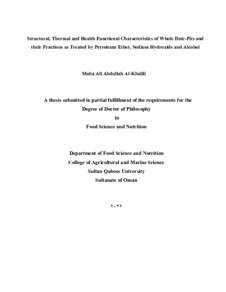وثيقة
Structural, thermal and health functional characteristics of whole date-pits and their fractions as treated by petroleum ether, sodium hydroxide and alcohol.
الناشر
Sultan Qaboos University.
ميلادي
2022
اللغة
الأنجليزية
الملخص الإنجليزي
Date-pits are agro-byproducts, and it can be valorized to food ingredients, bio-composites, and
biomass production. It can be a cheap source of potential functional ingredients, such as fibers,
proteins, fat, and antioxidant compounds. In this work, different fractions of whole date-pits (WDP)
were prepared from Khalas variety. These were: (i) defatted date-pits (DDP), (ii) digested by single
alkaline followed by pH dependent precipitates ( i.e. residue after digestion, REP-۱; residue
precipitated at pH ٥٫٥, REP-۲; residue precipitated at pH ۱٫٥, REP-۳), (iii) pressure cooked in alcohol water mixture (residue, REP-A; precipitate, SUP), and (iv) double alkaline digestion (i.e. no alcohol)
(ALK), and pressure cooked in alcohol-water mixture followed by double alkaline digestion of the
residue (i.e. ALH).
In the case of DDP, Differential Scanning Calorimetry (DSC) showed three types of relaxations, lower
one structural relaxation (i.e. -٥ o
C), followed by a glass transition (i.e. ۱۳٦ o
C) and solids melting decomposition (i.e. ۱۷۱o
C). LF-NMR showed three pools of protons, rigid, semi-rigid and mobile.
Rigid protons showed two types of relaxations, first one low temperature increase (-۸۰ to -٤۰ o
C),
plateau region (-٦۰ to -٤۰ o
C) and a positive peak at ۱۲۰ o
C, and semi-rigid showed maximum peak
at -٥o
C and minimum peak at ۱٥۰o
C. Mobile protons showed low relaxation (-۸۰ to -٤۰ o
C), a
maximum peak at ۷۰ o
C and a minimum peak at ۱۳۰ o
C. The maximum peak (i.e. -٥o
C) of semi-rigid
protons was similar to the DSC structural change, while the maximum peak of rigid protons (۱۲۰ o
C)
was similar to DSC glass transition (i.e. ۱۳٦ o
C). The minimum peak of the semi-rigid protons (i.e.
۱٥۰ o
C) was similar to the solids melting-decomposition (۱۷۱ o
C). DMTA showed five regions of
mechanical relaxations, glassy region (i.e. onset at ۳۲ o
C), glass transition (i.e. ۳۲-۸٥ or ۸۷o
C), first
reaction region with a plateau or peak (۸٥-۱٤۰ o
C), second reaction region (۸۷-۱۷٤ o
C), and softening
or decomposition region (۲۲۳ or ۲٤۲ o
C).
The visual structures of the fractions (i.e. DDP, REP-۱, REP-۲, and REP-۳) were determined by Field
Emission Scanning Electron Microscope (FESEM). Fractions DDP showed that lignin was coated
over holocellulose, however alkaline digestion clearly showed lignin-coating was removed and
fraction REP-۱ contained two main types of structural matrix (i.e. micro-size trapezoidal particles
were embedded in nano-size fine interconnected fibers). REP-۲ showed highly porous particles, while
REF-۳ showed that spherical particles were imbedded in an interconnected matrix. Infrared Fourier
Transform (FTIR) peaks within the wave number ٤۰۰-٤۰۰۰ cm-۱ showed different molecular
structures of the fractions. X-ray (XRD) patterns showed different crystallinity in the cases of different
fractions. The crystallinity of the REP-۱ and REP-۳ were ۷٦٫۷ and ۹٥٫٥٪, respectively and REP-۲
was mainly amorphous in nature.
Similar water absorption, increased hygroscopicity, and decreased solubility were observed in the case
of REP-A as compared to SUP. SEM showed that DDP resulted in collapse structure after extraction
of oil, and REP-A showed bigger size particles as compared to the SUP fraction. WDP and SUP
fractions showed two glass transitions, while DDP and REP-A showed single glass transition. Onset
first glass transition of WDP was observed at ۱٥٤٫٦ o
C, mid at ۱٥٤٫۸ o
C and end at ۱٥٥٫۰ o
C,
respectively. Total specific heat changes of WDP, DDP, REP-A, and SUP fractions were at ٦٥۹, ۲۱٦,
۱٤۹ and ۱۰۳۲ J/kg o
C, respectively, which indicated that SUP fraction showed highest portion of
amorphous component as compared to the other fractions. This was also supported by the XRD data
having Ruland-crystallinity of ٥۲٫۰٪ (i.e. REP-A) and ۹٫٦٪ (i.e. SUP), respectively. FTIR analysis
indicated different molecular structure of SUP as compared to REP-A fractions as evidenced from the
highest energy absorption for all selected functional groups.
A dynamic temperature-humidity (DTH) controlled chamber was developed to measure water sorption
isotherm as compared to the conventional isopiestic method. Temperature and relative humidity of
DTH chamber can be controlled in the range of -۱٥ to ۱۰۰ o
C and ۰ to ۹۸٪, respectively, thus
measurement of water activity at any point can be measured within the above ranges. DTH chamber
method showed high reproducibility as compared with the conventional isopiestic method when
measured isotherm of cellulose, lignin and hemicellulase were compared at ۳۰o
C. Finally, isotherm
data of cellulose, lignin, and hemicellulase were generated in the temperature range of ۱۰-۹۰ o
C using
DTH chamber, and these were modelled by BET and GAB equations. The model parameters were
correlated with the temperature.
المجموعة
URL المصدر
قالب العنصر
الرسائل والأطروحات الجامعية

